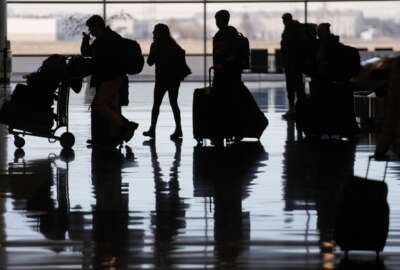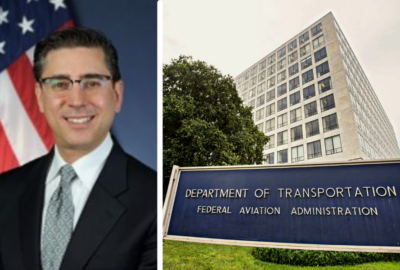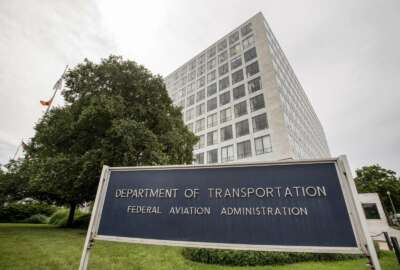The Transportation Department says farewell to one of its most distinguished employee
The Transportation Department bid farewell to Anne Aylward, who was the first woman to direct the department's Volpe Center.
The first woman to direct the Transportation Department’s Volpe Center recently retired. Anne Aylward, a 20-year federal employee, previously worked for the Massachusetts Port Authority for 20 years. Now she’s among the new inductees to the National Academy of Public Administration. Aylward joined the Federal Drive with Tom Temin to discuss.
Interview transcript:
Tom Temin: Let’s begin with the Volpe Center. It’s not an acronym, as I think we pointed out before we got started here as having grown up in Massachusetts. I remember Gov. (John A.) Volpe at the time. What goes on in the Volpe Center? I’m not sure even a lot of federal employees know.
Anne Aylward: Volpe Center is part of the Department of Transportation Office of the Secretary. It’s a research and technology organization that provides service to all of the Department of Transportation, as well as other federal, state and local organizations focusing particularly on transportation technology, innovation and research. Volpe Center has about 700 employees ranging from engineers to planners to social scientists and everyone in between. It’s a multi-multimodal, multidisciplinary organization.
Tom Temin: And does it do the research itself or is it primarily a grantmaking organization?
Anne Aylward: Volpe Center is not have a grant-making authority. It undertakes research, sometimes working in federal contractor teams, but largely the work is done by federal staff.
Tom Temin: And does it also include, well, what are the modes of transportation that it specializes in?
Anne Aylward: Literally, Volpe does all works across the transportation spectrum. We provide service to the components of the Department of Transportation from the Federal Aviation Administration, which is the largest of Volpe’s customers, to the Great Lakes-St. Lawrence Seaway, which interestingly is the other operating organization within DOT and all of the organizations in between. Federal Highway, Federal Railroad, Federal Motor Carrier, Safety Administration, Maritime Administration. Volpe also provides transportation assistance to organizations such as the National Park Service, which don’t have their own transportation planning capabilities but have enormous needs in terms of transportation planning.
Tom Temin: And is it primarily safety related, or does it also have to do with, as you say, planning for capacity and throughput, if you will?
Anne Aylward: Both. Transportation safety is obviously the primary priority for the Department of Transportation, but Volpe staff works on not only safety improvements but technology efficiency, climate change, equity issues, really across the board.
Tom Temin: And relative to, say, 20 years ago, certainly relative to 40 years ago, most of the modes of transportation or the biggest one say air and automobile are in some ways step functions safer than they were thanks to multiple air bags and a million kinds of things that have come into cars that we never dreamed of. Same thing with air safety. There hasn’t been a fatal air crash from a domestic commercial carrier in many, many years in the United States.
Anne Aylward: Don’t even say it out loud.
Tom Temin: I know. Yeah, you’re right. As a frequent flyer, I hate to say it. But how did you know in the Volpe Center, how did you set the priorities for what we need to do next to keep that kind of cadence going?
Anne Aylward: Transportation safety. If you think of transportation safety, it’s really a three-legged stool. You have investment in improving the safety of the vehicles. You have investment in improving the safety of the infrastructure, the roads, the rails, and you have investment in improving the transportation operators, the human factors, transportation. All three of those are essential to improving the safety of the system as a whole. One of the places we’ve seen enormous change in the last 20 years is in the application of automation and automated technology to transportation and to improving the safety of the transportation system. But what’s really important is bringing together the three legs of that safety stool, to be sure that the human factor is investment is enhancing the investment in infrastructure in vehicles. Often, the direction of that research and investment is driven by recent experience in transportation safety. Laboratory staff is very much involved in the forensics of transportation safety in the rail area. For example, if there is a crash, Volpe staff will be called to the scene to work side by side with the NTSB to investigate the causes of that accident and then undertake research as to how that particular situation can be avoided in the future.
Tom Temin: We are speaking with Anne Aylward. She recently retired as director of the Transportation Department’s Volpe Center. She’s also a new inductee to the National Academy of Public Administration. And in your career, both here and in Massachusetts, are you primarily an administrator or do you have a particular branch of transportation that you might have had some exercise authority in at some point way back?
Anne Aylward: Well, my undergraduate degree is in Asian history, so let’s just put that one on the table. I have a master’s degree from MIT in planning, and I began my career, as you may have mentioned, at the Massachusetts Port Authority as a transportation planner, and served there for 10 years as port director. So my personal expertise is in freight and intermodal transportation. I served as the director of the National Commission on Intermodal Transportation, which made recommendations to Congress to improvements in the freight transportation system.
Tom Temin: Yeah, in Massachusetts, especially, like so many coastal cities, the airport is sitting right on the water not far physically. You can almost throw a rock to where the ships come in and then the rail goes right by there and the highways go right by there. So multimodal from your standpoint, that’s at least four major modes all converging.
Anne Aylward: And that’s not uncommon. If you look at the impact of the recent hurricane in Western North Carolina and that part of the country, in many cases going through the Appalachians, the road and the rail run alongside the river because that was the easiest way to get through the mountains. Well, that’s great until the river suddenly surges 20 or 25 foot above its normal levels, takes out the entire roadway system in the entire rail system. So as we see more extreme weather, the impacts on the transportation system are potentially enormous.
Tom Temin: So resilience then would be probably a high priority for a place like Volpe.
Anne Aylward: Resilience and planning for resilience is tremendously important.
Tom Temin: And as a NAPA Fellow, I mean, sometimes the NAPA Fellows have to work, just not go to lunch there and stuff. And they put you on a commission to look at congressionally chartered, to look at a particular agency. What do you hope to do there at NAPA?
Anne Aylward: Well, I’m still learning the NAPA process. Probably I won’t be going to lunch since I’m in Boston and I’ve found you can do a lot of things virtually. But being invited to lunch doesn’t work well. But I look forward to contributing in any way that I can. As we discussed, I’m particularly interested in the movement of goods in freight. I think we all learned during the pandemic how important the functioning of our supply chain is to the health of the economy. That’s a place I think I can make a particular contribution, but also the application of technology and automation to government and particularly to the transportation system. You can’t be a manager in the government for as many years as I have without understanding the importance of how to create government structures that can be administered effectively and efficiently. And so I have a particular interest in that area as well as part of what is complicated about our country are the levels of institutions. If you live in the Netherlands, you can make a national decision and it can be implemented in the United States. You make a national decision. You have to be working through hundreds of state and local government organizations. So that administrative capability is something that I find particularly interesting.
Tom Temin: Wow. Yeah, that’s right because having worked for an authority, which is separate in some ways from the state government, you have different accountabilities, different people to answer to, and you bring up a good point. Final question, what’s your best advice for the young federal employee just coming into civil service?
Anne Aylward: Public service is addictive. Once you come into the public sector, it’s very hard ever to leave again. It’s a place where you can genuinely make a difference. It has been very exciting at the Volpe Center over the last five years to see more than a third of the employees at the Volpi Center are new within the last five years, and they have come to government with a goal to make the world a better place. And it’s a way you can give back.
Copyright © 2025 Federal News Network. All rights reserved. This website is not intended for users located within the European Economic Area.
Tom Temin is host of the Federal Drive and has been providing insight on federal technology and management issues for more than 30 years.
Follow @tteminWFED






